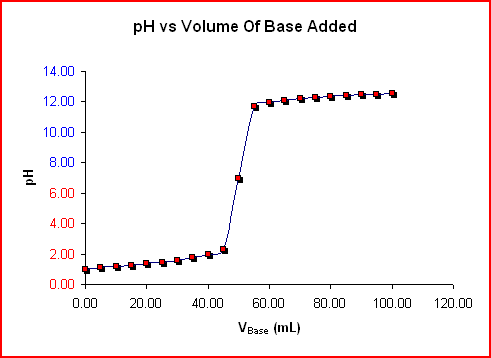Strong Acid-Strong Base Titration

The graph below is a titration curve for a strong acid and a strong base. The net ionic equation for the reaction is:
H+(aq) + OH -(aq) —> H2O(l)
The titration curve for a strong acid, unlike a weak acid, begins at a lower pH. This is expected because initially there is only the strong acid such as HCl which completely ionizes.
Unlike with a weak acid, there is very little change in pH as the base is initially added. The small amount of base neutralizes an equimolar amount of acid with an excess amount of acid remaining. The hydrogen ions supplied by the excess acid exist in increasing amounts of water produced from the neutralization. As a result, the pH changes slowly.
Unlike with a weak acid, there are greater changes in pH near the equivalence point. The midpoint of the vertical section of the curve is the equivalence point indicating when equimolar amounts of acid and base are present. At the equivalence point, the H+ has been neutralized by the OH - leaving a neutral solution. The final solution contains water, Cl - from the strong acid and Na+ from the strong base. Because neither the sodium nor the chloride ions hydrolyze, the pH of the solution will always be 7.00.
After the equivalence point has been reached, the titration curve for the strong acid is the same as the titration curve for the weak acid because the pH depends on the excess OH - in both titrations.
